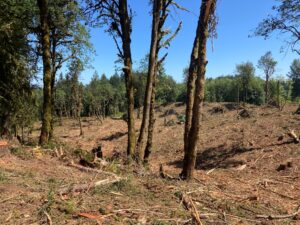![]() Ever wonder what a Department of Natural Resources (DNR)–approved clearcut of public forestland looks like after the fact? Our Whatcom County field team got a close look at the wreckage when we walked the recently cut Oyster timber sale near Lake Whatcom.
Ever wonder what a Department of Natural Resources (DNR)–approved clearcut of public forestland looks like after the fact? Our Whatcom County field team got a close look at the wreckage when we walked the recently cut Oyster timber sale near Lake Whatcom.
We found the skeleton of a forest with every bone broken. Trees razed, land savaged, the entrails of a dead beauty left withering in the sun.
Like the neighboring forest visible along the boundaries of the clearcut, Oyster was once an ecologically complex, lush and shady haven, watered by cool, clear streams. Now the sun burns down on a denuded and forsaken wasteland. Light glares off skinned logs lying in disordered heaps, tangled with piles of severed branches.
Logging roads and tire tracks snake across the now unrecognizable forest floor: a torn and muddy landscape clogged with sawdust, wood fragments and withered vegetation. Meager groups of spindly “leave trees’’ stand together awkwardly against an empty sky. Little rivulets of water run haphazardly across the road, evidence of disrupted streams that once carried clean, cool forest water into the watershed. Today, water pools stagnantly in random spots, likely to evaporate rather than be absorbed by the scarred earth.
Stacked along the logging road lie the largest logs, soon to be hauled away. Some measure over four feet in diameter, the remnants of trees that once soared high overhead, supporting a canopy that helped our biome regulate climate, store carbon and provide a home for birds and wildlife.
Now an angry orange where they’ve been cut, the freshly severed logs and stumps bleed sap from their slashed veins. Shards of snapped–off wood stick up in a line across the center of the stumps as if mirroring, in miniature, the sparse and jagged skyline they face today. The massive stumps’ exposed rings will remain as the sole record, silent testimony to quiet mysteries and miracles performed by these trees, decade after decade—the work that only a healthy forest can do for the world.
This is “land management” in the year 2022? What a misnomer. Nothing has been “managed” here, nothing achieved, no thoughtful plans or decisions made. Just another run–of–the–mill slaughter. Just another day of insanity, of trading life for cash. The only difference is that this clearcut has been done in our name, in the name of the people.
We were too late to save the Oyster forest. There are too many forests on the chopping block each month to save them all—unless we the people demand what most of us actually want: for our older forests to be left in peace.
This is far from a radical request, given that nearly all the public forestlands in the Puget Sound lowlands are already being “managed”—sold for timber and clearcut.
It’s too late for Oyster, but there’s still time to save Box of Rain, Brokedown Palace, Delica, Sprinter, Aldwell Sorts, Bedford Sorts, VTwin, Fir Reals Sorts, Penny Wise, Midge Sorts and dozens of other beautiful forests scheduled for destruction across Washington State.
The DNR has slated these and thousands of acres of other Legacy Forests for clear cutting over the next few years. We have so much to lose right now. This won’t stop until we make it stop. New organizations and new leaders have emerged to help concerned citizens across the state add their voices to this struggle. This is the only way to preserve Washington’s rapidly vanishing natural legacies, forests that deserve our protection as they struggle to hold together our increasingly fragile landbase for as long as they can, for everyone’s sake.
Sarah Gardam works in nonprofit communications. She lives in Whatcom County.

I have to say I’m confused about what the DNR actually stands for. If conservation/protections, etc is their “mission” why are they continuing to clear cut areas. Isn’t that anathema to what they stand for? Please help me understand why their plans include so much clear cutting of land.